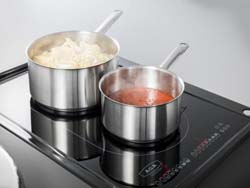Induction Cooking
The most efficient hob available.

Controllable
Turns up and down with the responsiveness of gas.
Easy to Clean
No awkward pan supports or trivets for the splashes and boil-overs to stick to - just an easy-to-wipe toughend glass panel.
And your house stays cleaner too - burning gas (on a gas hob) produces a lot of moisture - water vapour is one of the main 'products of combustion' which contributes to dampness in the house.
Safer
There's no naked flame like a gas hob, and no super-hot glass surface like an electric-ceramic hob.
You can't leave an induction hob on and forget about it either - pan detection means it'll turn itself off when the pan is taken away. There's less residual heat so the glass surface doesn't get as hot as ordinary 'ceramic' or gas hobs. (And there's a residual heat indicator for when it's turned off too.)
Copes with virtually any pan size
Modern induction hobs often allow two cooking zones to be combined to make one large one for big or odd-shaped pans. (Usually called the 'bridging' function.)
Super-Efficient
Induction hobs are around 80-90% efficient - much better than gas or ordinary ceramic hobs and much more in keeping with today's drive to use less energy.
Note - Pacemakers
It's generally accepted that it's very unlikely that a domestic induction hob can affect a pacemaker however if you do have one fitted it's recommended to stay at least 600mm (24") away from the induction zone. Ask your medical specialist who'll be able to advise with more certainty on the do's and don'ts.
How Does It Work?
'Electromagnetic Induction'
Put simply: if you pass a current along a copper wire it produces a magnetic field. Conversely, if you move a copper wire through a magnetic field it generates a current in the wire. These two effects are linked - we'll generalise and call it 'electromagnetism'.

Magnetic Flux

Induction hobs work by harnessing this effect - they have a coil of copper wire and pass an alternating ('ac') current through it.
The hob is designed so a fluctuating magnetic field is concentrated where the pan sits, and when the base of the pan is made of a 'ferrous' material (usually steel or iron - aluminium or copper won't work) an electric current is 'induced' within it.
Eddy Currents
This isn't quite the same as the electricity going to a light bulb; it's a fluctuating, swirling 'eddy current' which as it flows backwards and forwards through the base of your pan dissipates its energy as heat and voila! The pan's base gets hot and cooks your food.

Controllable
Since the electrical energy flowing through the coil can be controlled quickly and easily so can the energy going to the pan - this is why induction hobs are so responsive and controllable. It also means that the flow of energy can be monitored and since this changes if you lift the pan off, the electronics know that the pan's not there and can cut the power to the coil.


